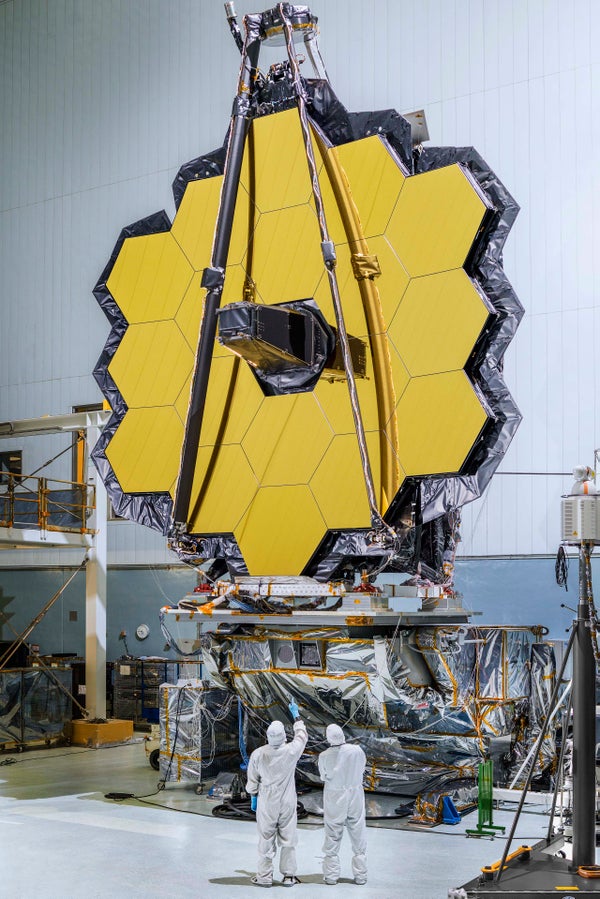Astronomers are scrambling to keep a rapidly approaching date with destiny—a chance to gaze farther than ever before into the universe’s hidden depths.
After decades of development, the nearly $9-billion James Webb Space Telescope is set for launch from French Guiana in spring 2019. Built in cooperation with the European and Canadian space agencies, Webb is NASA’s biggest, costliest and most powerful observatory yet, boasting a 6.5-meter primary mirror that will be the largest ever flown in space.
Unlike its famous predecessor the Hubble Space Telescope, which mostly was set up to gather visible and ultraviolet light, Webb is optimized to view the cosmos in infrared. At some wavelengths, infrared light can pass through dust almost unscathed, like a sunbeam through a windowpane; at others, it mingles with matter to carry away imprints of its atomic and molecular structure. It is also the brightest light we have from the most distant (and oldest) stars because their otherwise-visible light arrives stretched out to longer, redder wavelengths by more than 13 billion years of the universe’s expansion. Webb’s infrared eyes make it equal parts x-ray scanner, mass spectrometer and time machine. With them it will peer through the creaking, dusty cosmic eons to study much that astronomers using Hubble and other telescopes have barely begun to glimpse: the universe’s very first galaxies, nascent stars and planets in mid-creation in nebulous wombs, the atmospheres of worlds both within and beyond our solar system.
On supporting science journalism
If you're enjoying this article, consider supporting our award-winning journalism by subscribing. By purchasing a subscription you are helping to ensure the future of impactful stories about the discoveries and ideas shaping our world today.
Longevity is an even greater difference between Hubble and Webb. Thanks to a series of refurbishing missions to its post in low Earth orbit, Hubble is approaching its fourth decade of operations, a life span that has helped make it arguably the most productive and revolutionary scientific instrument in human history. Webb, however, will be stationed in deep space, past the orbit of the moon, out of reach of easy servicing. It is intended to last at minimum five years—perhaps even 10, if all goes according to plan. For astronomers hoping to squeeze Hubble-like levels of discovery out of Webb’s limited life, every moment of the telescope’s time will be precious.
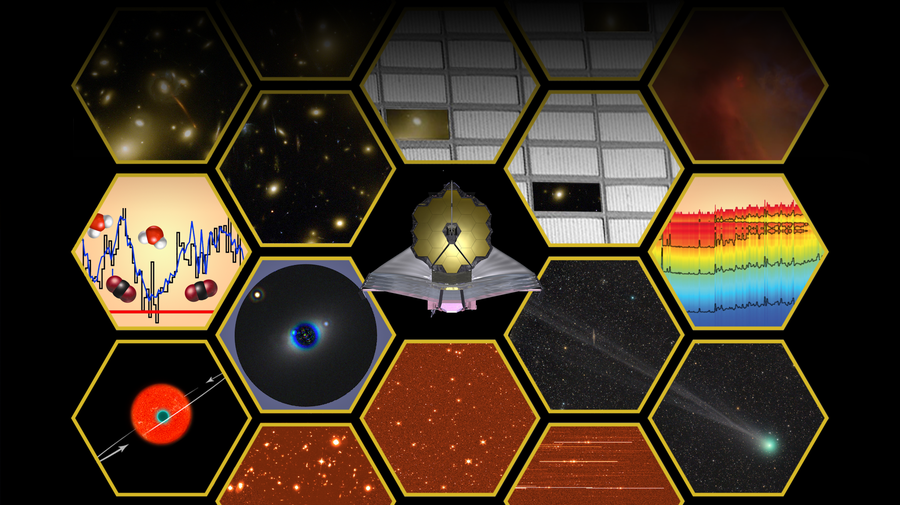
An artist’s rendition of the James Webb Space Telescope (center) and its diverse scientific capabilities (surrounding hexagons). Designed to operate at infrared wavelengths, Webb’s four science instruments will make breakthrough observations of ancient galaxies, newborn stars and planets orbiting other suns while also studying multitudes of objects within our own solar system. Credit: STScI and NASA
Climbing Webb’s Learning Curve
“Webb has a finite lifetime, and represents huge intellectual, financial and technological investments, so we need to hit the ground running to get its science flowing,” says Ken Sembach, director of the Space Telescope Science Institute (STScI). “But there will be a steep learning curve. We want to make that curve as quick and easy to climb as possible.”
The hundreds of researchers who have spent decades developing the telescope's hardware, software and core scientific objectives will be among the first to scale that learning curve. Each member of this elite cadre is guaranteed a small but significant portion of Webb’s total time, and much of the telescope’s first year of observations (called “Cycle 1”) is dedicated to fulfilling that obligation. Already intimate with what the telescope can do and given first picks of where to point it, these research teams are expected to generate some of Webb’s most transformative discoveries. Those initial results could then guide the rest of the world’s astronomers as they clamor to use Webb before it is gone. Except, that is, for rules hammered out early in the telescope’s development, which allow the researchers performing these “Guaranteed Time Observations” to keep their results to themselves for a one-year period.
This delay “is an incredibly anachronistic concept, in the days of ‘big data,’ for an $8-billion mission funded with public resources with a five-year life,” says Garth Illingworth, an astronomer at the University of California, Santa Cruz, who also chaired an influential advisory committee for Webb. “The one-year proprietary period effectively means this hidden, unavailable data cannot be seen in time for follow-up by the community of astronomers until more than three years into [Webb’s] mission.” After unsuccessfully lobbying to change those rules, Illingworth instead helped create a new “Early Release Science” (ERS) program to circumvent them—up to 500 hours of diverse observations front-loaded to Cycle 1 for immediate release to the public, giving all astronomers a chance to absorb the results and apply lessons learned to Webb proposals of their own.
The precious hours for ERS would come directly from Sembach. As STScI’s director, he commands 10 percent of Webb’s available time, and on November 13 he announced the final selections of 13 ERS proposals out of more than 100 from large research teams around the world. Each successful proposal will not only pursue novel science with Webb but also develop new tools and techniques for using the telescope that all astronomers can subsequently employ. “Getting these substantial programs in the public domain puts everyone on a more level playing field,” Sembach says. “Good ideas are what should dictate [Webb’s] observations going forward, not the past successes anyone happens to have.”
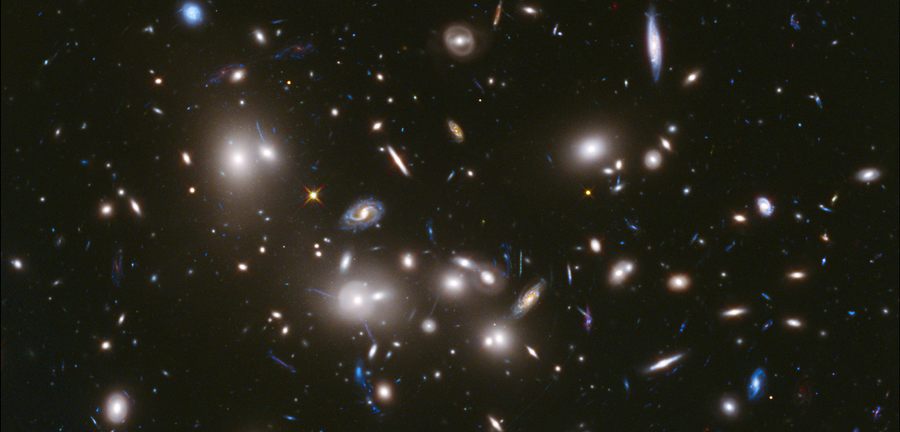
The Hubble Space Telescope’s view of Abell 2744, a galaxy cluster studied as part of Hubble’s “Frontier Fields” program. Magnified by the cluster’s immense gravitational field, a small number of very distant galaxies from the universe’s infancy appear as dim red spots in this image. Webb will study them in much more detail, and perhaps discover galaxies from even deeper in cosmic history. Credit: NASA, ESA, and J. Lotz, M. Mountain, A. Koekemoer, and the HFF Team (STScI)
Illuminating the Cosmic Dark Age
Astronomers have already begun leveraging Hubble and other space telescopes to create a preview of what Webb may reveal, staring at some of the largest galaxy clusters in a project called “Frontier Fields.” These clusters are so massive they warp the surrounding space, forming gigantic “gravitational lenses” that amplify the faint light from galaxies even farther away, ones born less than a billion years after the big bang. Such galaxies are thought to be almost as old as any can be; for most of the universe’s first half-billion years it languished in a cosmic “Dark Age,” too hot and dense for stars to form. But even through the galaxy cluster–size magnifying glass of a gravitational lens, Hubble can only see these early galaxies as dim smudges reddened by cosmic expansion. Webb—custom-built to study these murky epochs—could use gravitational lensing to unveil these and even older galaxies in sufficient detail and number to pin down exactly how these ancient objects arose and first brought light into the universe.
One ERS program led by University of California, Los Angeles, astronomer Tommaso Treu will do just that, pointing Webb at a Frontier Fields cluster called Abell 2744 to see what lies beyond the limits of Hubble’s view. “With these observations we can look at everything from the very first galaxies to what we call the peak of star formation, a few billion years after the big bang, when galaxies are churning out stars and heavy elements at a crazy rate,” Treu says. “We’ll get the timeline exact for how this all happened—how it proceeds, what its sources are and what those sources are like—big or small, rich or poor in heavy elements.”
Whereas Treu’s program will use gravitational lensing to go deep, others will go wide, simply tiling a celestial region with Webb’s infrared view. The ERS observations helmed by The University of Texas at Austin astronomer Steve Finkelstein will use Webb to image a strip of sky about an eighth the size of the full moon. Somewhere in that region, Finkelstein says, Webb might spy anywhere between a few to perhaps 50 extremely ancient galaxies. The number will help reveal the efficiency of star formation in the early universe, and could forecast exactly how far back in cosmic time Webb will be able to see.

Hubble’s view of the “Extended Groth Strip” from its CANDELS program, a galaxy-rich swath of sky about an eighth the size of the full moon. Webb will image this entire region in search of the universe’s first galaxies formed half a billion years or less after the big bang. Credit: NASA, Anton M. Koekemoer (STScI)
“At some point, far enough back, the galaxies will cease to exist,” Finkelstein says. “Maybe even just beyond the limits of the Frontier Fields. And that would mean you might not want to spend a lot of time looking for them, because they aren’t there to be found…. It may be we won’t see anything fainter with Webb—or maybe we will.”
Making Maps, Picturing Planets
Despite its origins as a workhorse for studying faraway galaxies, Webb will also make breakthroughs nearer to home. One ERS program will stare into the hearts of neighboring nascent star systems to watch ices, organic molecules and other planetary building blocks dance around coalescing suns. Another will seek out plumes of water vapor that may erupt from subsurface oceans on Jupiter’s icy moons. But for many astronomers Webb’s most anticipated work involves exoplanets—worlds orbiting other stars.
No exoplanets had been discovered when Webb was first conceived; now multitudes fill astronomers’ catalogues. Most come from a single NASA mission, the Kepler space telescope, which found thousands of worlds by watching for their shadowy “transits” as they periodically flit across the faces of their stars. Whereas these discoveries have offered broad information about planets in the Milky Way—sizes, masses and orbital periods—they have told us far less about climate, weather and habitability. Webb will not be able to snap actual pictures of alien Earths to see such details, but its exquisite optics could still help astronomers scan for Earth-like conditions on a handful of planets orbiting nearby stars.
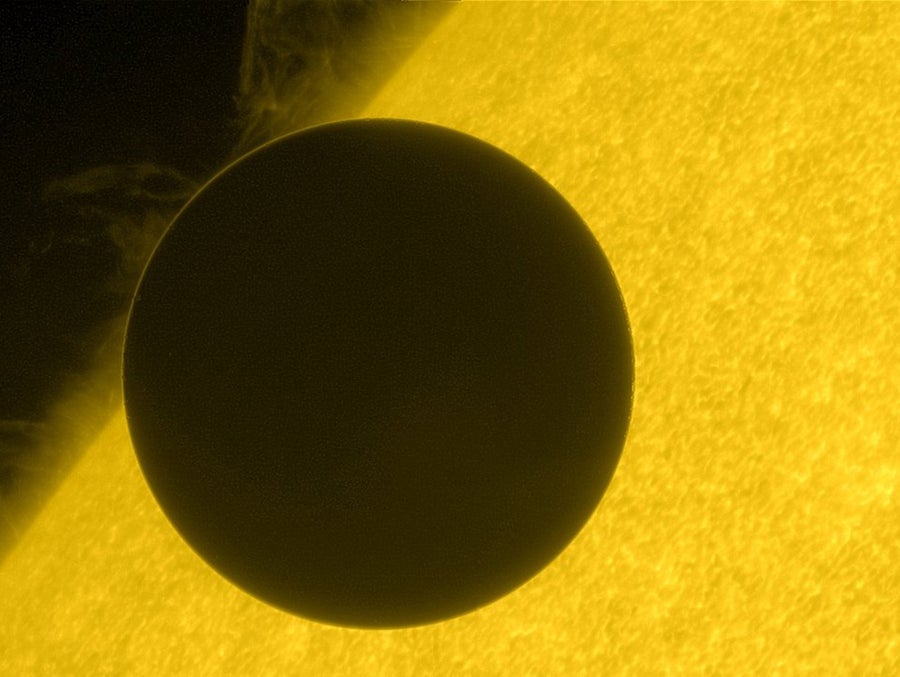
Venus appears silhouetted against the sun during its 2012 transit in this image from Japan’s Hinode satellite. Sunlight shining through Venus’s upper atmosphere appears as a thin ring around the planet; Webb will search a handful of transiting worlds for similar signatures of alien air. Credit: JAXA, NASA and Lockheed Martin
Unlike Kepler, which simply surveyed a single star-packed field of view for transits, Webb can zoom in on individual transiting worlds for deeper study. Astronomers should be able to use it to detect water vapor, methane, carbon dioxide and other gases in some silhouetted planets’ upper atmospheres by monitoring the starlight streaming through. They could also record a planet’s passage in front of and then behind its star, using the difference between the two observations to crudely measure a world’s temperature, weather patterns and clouds. “Webb is going to be great for exoplanets,” says Kepler project scientist Natalie Batalha, an astronomer at NASA Ames Research Center who leads the most time-intensive ERS program, which will use nearly 80 hours of Webb’s time to study transiting worlds. “It’s just that this is a difficult game to play, because the signals we’re looking for are really tiny. Seen [in transit] from another star, Venus blocks one part per ten-thousandth of the sun’s light, and its atmosphere intercepts one two-hundredth of that. It’s tough to see—you need a big mirror and great instrumentation to do it.”
For their observations, Batalha and her team have more modest goals. They plan to test-drive the telescope’s instruments on two transiting Jupiter-size worlds, WASP-39 b and WASP-43 b, gleaning as much data as possible from the shifting patterns of starlight and planetary shadow. What they learn may help plan observations of smaller, potentially rocky and more Earth-like worlds that would require heftier investments of Webb’s limited time. And ultimately it could point the way toward what many planet hunters consider their holy grail: obtaining actual images of an Earth-like planet orbiting another star.
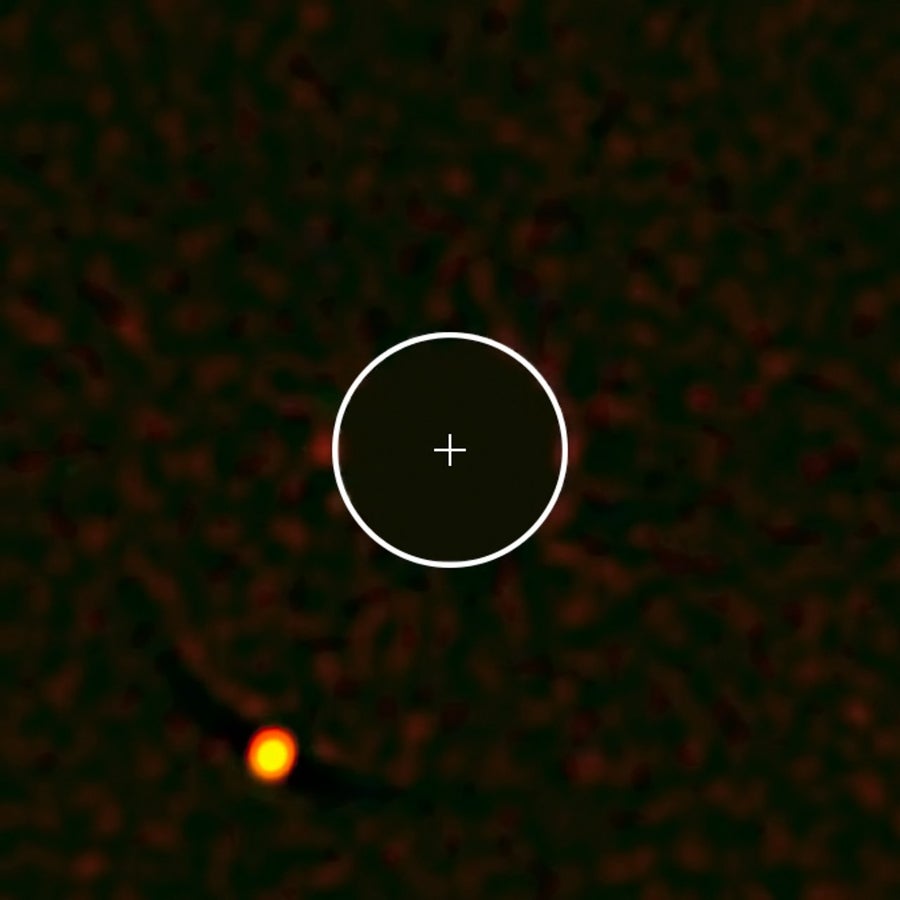
The giant exoplanet HIP 65426 b, seen here in its discovery image from the European Southern Observatory’s SPHERE instrument on the Very Large Telescope in Chile. The planet’s parent star has been removed from this image, and its position marked with a cross; the circle indicates the orbit of Neptune around our sun on the same scale. Webb will obtain new, better images this world and others like it, providing crucial data for theories of planet formation. Credit: ESO
Taking a picture of a planet outside our solar system is a tall order; even the largest, brightest world would be almost imperceptibly faint in the glare of its parent star. Webb’s large mirror and optimization for infrared light, which is most favorable for planet–star contrasts, make it a formidable albeit imperfect tool for the task. Lacking a high-performance coronagraph—an instrument that blocks most of a star’s light—Webb will probably struggle to take pictures of planets smaller than Saturn in even the best of circumstances. It will, however, help pave the way for far more capable future planet-imaging observatories.
“If you polled my community about what we’d wish for our ideal observatory, it wouldn’t be Webb—it would be something else,” says Sasha Hinkley, an astronomer at the University of Exeter in England leading an ERS program to directly image giant planets. “Webb doesn’t have the resolution that we’d like—we would like something with a much bigger mirror to look at smaller planets closer to their stars. But Webb does have this incredible [infrared] wavelength coverage and sensitivity. We’ll be trying to milk it for everything it can offer.” Hinkley’s team will point Webb at three stars thought to harbor planets, looking for new worlds and capturing images of at least one already known—a young “super-Jupiter” called HIP 65426 b that is still aglow with the leftover heat of its birth. Measuring the planet’s brightness and color will allow Hinkley’s team to better estimate its composition and age—two crucial data points for determining how exactly it formed, which could shed light on how Jupiter formed, too.
“We’ve never looked at these systems before with the sensitivity of Webb, so it’s not unlikely that we could discover lower-mass planets that we weren’t sensitive to in previous ground-based observations of these stars,” Hinkley says. “But to do that we’ll need to rapidly develop our understanding of this incredible observatory, the most complicated space telescope that humankind has ever built.”
